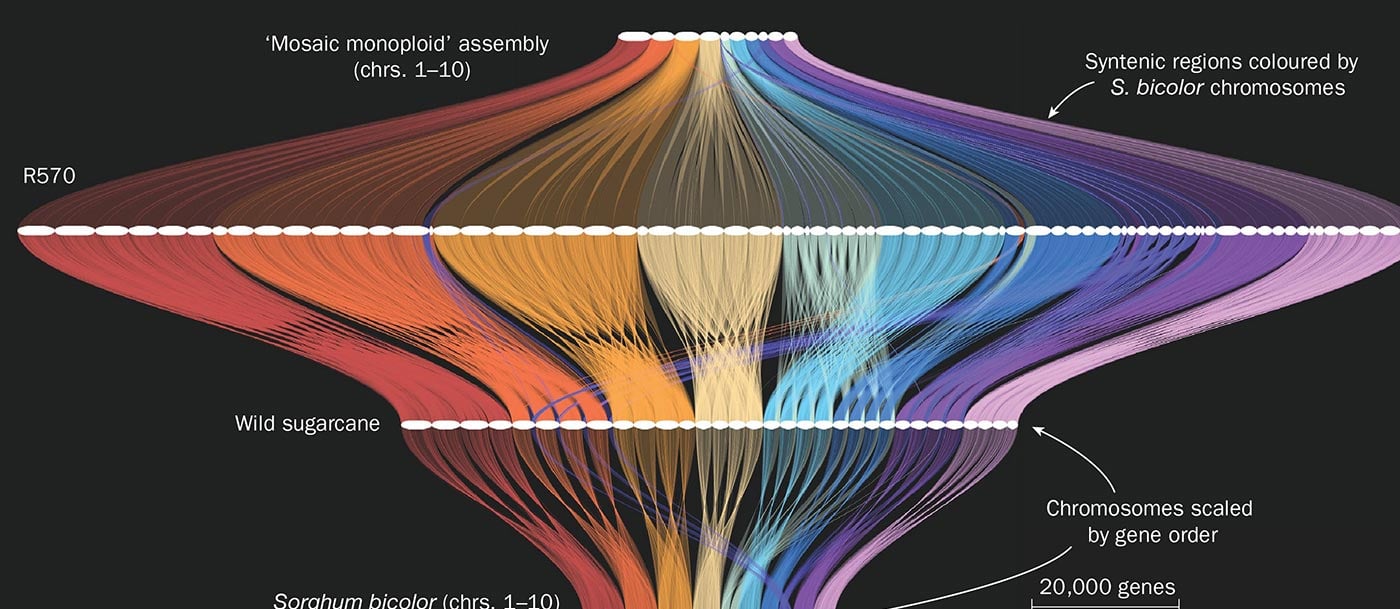
The Mapping of the Sugarcane Genome: A Milestone in Agricultural Science
Table of Contents:
1. Introduction to Modern Hybrid Sugarcane
2. Advances in Sugarcane Genetic Research
3. Understanding and Utilizing the Sugarcane Genome
4. Potential Impact on Agriculture and Bioenergy
5. Reference
6. FAQs
Introduction to Modern Hybrid Sugarcane
Modern hybrid sugarcane is a vital crop used in the production of sugar, molasses, bioethanol, and bio-based materials. It has a complex genetic blueprint that has posed challenges for researchers in the past. However, recent advancements in genetic sequencing techniques have allowed scientists to map out the sugarcane genome accurately.
Sugarcane has a large genome with approximately 10 billion base pairs, making it one of the most complex crops genetically. Its polyploidy nature, with multiple copies of chromosomes, adds to the complexity of its genetic makeup.
Despite these challenges, researchers have successfully created a highly accurate reference genome for sugarcane, providing valuable insights into its genetic code.
Advances in Sugarcane Genetic Research
The research conducted as part of the Community Science Program at the U.S. Department of Energy Joint Genome Institute (JGI) has resulted in a breakthrough in sugarcane genetic research.
By combining multiple genetic sequencing techniques, including the innovative PacBio HiFi sequencing method, scientists have successfully mapped out sugarcane’s DNA.
The reference genome of sugarcane has enabled researchers to identify key areas related to sugar production, transport, and disease resistance. One significant finding was the discovery of genes that provide resistance to brown rust, a destructive disease that can severely impact sugarcane crops. Understanding these genes could pave the way for developing more resilient and productive sugarcane varieties.
Understanding and Utilizing the Sugarcane Genome
Having a complete reference genome for sugarcane opens up new possibilities for crop improvement and disease management. Researchers can now compare sugarcane genes and pathways with those of other well-studied crops, facilitating a better understanding of how each gene influences traits like sugar production and disease resistance.
The study identified specific genes responsible for conferring resistance to brown rust in sugarcane. By unraveling the genetic mechanisms behind this disease resistance, researchers can potentially apply this knowledge to protect other crops facing similar pathogens. Understanding the genetic basis of sugarcane traits can also aid in breeding more resilient and high-yielding varieties.
Potential Impact on Agriculture and Bioenergy
The implications of the sugarcane genome mapping extend beyond agriculture to bioenergy development. Improved understanding of sugarcane genetics can lead to the development of varieties that produce higher sugar yields, benefiting both sugar production and biofuel generation.
Sugarcane is a crucial feedstock for biofuel production, particularly ethanol. Enhancing sugarcane’s sugar production capabilities can increase biofuel yields and contribute to sustainable energy production. Additionally, the utilization of sugarcane residues, such as bagasse, for biofuel production can further enhance the sustainability of bioenergy technologies.
Reference
The study on the complex polyploid genome architecture of sugarcane was published in the journal Nature on March 27, 2024. The research involved collaborations with institutes from around the world, highlighting the global effort to advance sugarcane genetic research and crop improvement.
Reference: “The complex polyploid genome architecture of sugarcane” by A. L. Healey, O. Garsmeur, J. T. Lovell, S. Shengquiang, A. Sreedasyam, J. Jenkins, C. B. Plott, N. Piperidis, N. Pompidor, V. Llaca, C. J. Metcalfe, J. Doležel, P. Cápal, J. W. Carlson, J. Y. Hoarau, C. Hervouet, C. Zini, A. Dievart, A. Lipzen, M. Williams, L. B. Boston, J. Webber, K. Keymanesh, S. Tejomurthula, S. Rajasekar, R. Suchecki, A. Furtado, G. May, P. Parakkal, B. A. Simmons, K. Barry, R. J. Henry, J. Grimwood, K. S. Aitken, J. Schmutz and A. D’Hont, 27 March 2024, Nature. DOI: 10.1038/s41586-024-07231-4
FAQs
1. What is the significance of mapping the sugarcane genome?
Mapping the sugarcane genome is a significant scientific milestone that unlocks new possibilities in crop improvement and disease management. It provides valuable insights into the genetic basis of traits like sugar production and disease resistance, leading to the development of more resilient and productive sugarcane varieties.
2. How can the sugarcane genome mapping impact agriculture and bioenergy?
The mapping of the sugarcane genome can lead to the development of sugarcane varieties with higher sugar yields, benefiting both sugar production and bioenergy generation. Improved understanding of sugarcane genetics can enhance biofuel production from sugarcane residues like bagasse, contributing to sustainable bioenergy technologies.
3. What techniques were used to map the sugarcane genome?
Researchers employed multiple genetic sequencing techniques, including the innovative PacBio HiFi sequencing method, to accurately map out the sugarcane genome.
By combining these techniques, scientists were able to overcome the challenges posed by sugarcane’s complex genetic makeup and create a highly accurate reference genome.
4. How can the discovery of genes conferring disease resistance in sugarcane benefit other crops?
The identification of genes that provide resistance to brown rust in sugarcane can serve as a model for understanding disease resistance mechanisms in other crops facing similar pathogens.
By studying these genes, researchers can potentially apply this knowledge to develop more resilient crop varieties and enhance disease management strategies in agriculture.
5. What are the potential applications of the sugarcane reference genome in crop improvement?
The sugarcane reference genome can aid breeders in identifying genes that control desired traits for improved production. By tracing the origin of these genes from each parent, researchers can develop sugarcane varieties with enhanced traits like sugar yield and disease resistance. This knowledge can drive advancements in crop improvement and agricultural productivity.
In conclusion, the mapping of the sugarcane genome represents a significant scientific achievement with far-reaching implications for agricultural productivity and bioenergy development.
By unlocking the genetic secrets of sugarcane, researchers can pave the way for more resilient and high-yielding crop varieties, benefiting both the sugar industry and biofuel production.
The collaborative effort involved in this research showcases the global commitment to advancing crop genetics and enhancing food and energy security for a sustainable future.




















